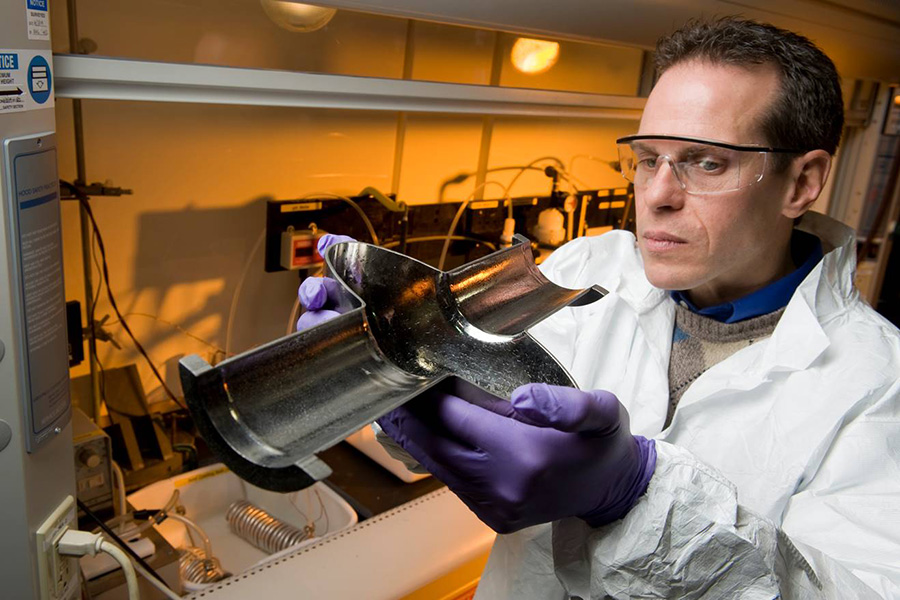
When you think particle accelerator, you think big. CERN’s Large Hadron Collider, for example, spans two countries, features a tunnel more than 16 miles (27 km) long, employs thousands of scientists and requires a budget of $1 billion a year.
Turns out, particle accelerators need not be so massive. In fact, proton-smashing technologies initially developed to reveal the mysteries of the universe are being scaled down to solve less lofty, but no less important, problems related to environment, health and safety.
The Florida State University-headquartered National High Magnetic Field Laboratory is playing a role in a nationwide effort to make human-scale particle accelerators for a host of applications. With a $1 million grant from the U.S. Department of Energy, scientists at the lab’s Applied Superconductivity Center are developing a key component of these slimmed-down accelerators called radio frequency (RF) cavities.
“They can be used for everything from zapping cancer cells to curbing pollution to scanning cargo for contraband,” said Lance Cooley, an ASC scientist and professor at the FAMU-FSU College of Engineering who is leading the RF cavity research.
Whether made of protons, electrons or ions, beams generated by accelerators can break up unwanted molecules like coal flue gases or bacteria; catalyze processes helpful in industry and manufacturing; and identify nefarious stowaways hidden in shipping containers. The list of potential applications is long.
“The can be used anywhere you need a catalyst or an X-ray,” Cooley said.
But downsizing complex technologies to a size both portable and affordable is a massive challenge that requires solving lots of engineering problems.
Cooley is focused on the problem of designing an RF cavity that doesn’t require the fancy infrastructure used in large-scale accelerators and doesn’t break the bank.
RF cavities boost the speed of particles as they pass through them; in the Large Hadron Collider at CERN, for example, 16 cavities work to build up the particles’ velocity to close to the speed of light. When radio waves of just the right frequency are funneled into the cavities, they bounce around inside, creating oscillating electric and magnetic fields that, when timed just right, propel the particles forward.
It’s similar to what happens inside microwave ovens, but with much higher energy and, of course, a different objective. To minimize any loss of energy, the cavities are made of superconducting materials, which carry electricity with perfect efficiency.
The superconducting material most often chosen to make these cavities is niobium. But it’s an expensive element, and RF cavities made out of the stuff fetch as much as a Ferrari, said Cooley, making it impractical for most applications.
That’s where the expertise of Cooley and his ASC colleagues comes in. Their contribution is finding a way to coat a cavity fashioned of less expensive copper with a superconducting layer of niobium-tin.
“For me it’s the logical approach to an affordable, industrial accelerator cavity,” Cooley said.
ASC has worked with niobium-tin for decades, refining superconducting wires for use in magnets at the National MagLab and other facilities.
“That’s why we can succeed where other groups might not,” Cooley said.
Traditional, low-temperature superconductors only perform at extremely cold temperatures that require the use of liquid helium, which complicates the engineering of a small-scale machine. Part of the project’s challenge lies in engineering a material that can perform at slightly warmer (in relative terms) temperatures that can take advantage of less complex, more compact cryogenic devices.
Niobium-tin offers that potential.
“We can take advantage of a portable cooling device with an ‘on/off’ switch, which lets the accelerator come to the application,” Cooley said.
Cooley’s collaborators on the project are ASC Associate Director Peter Lee; Professor Choong-un Kim of the University of Texas–Arlington; and John Buttles, CEO of DMS-South / Bailey Tool LLC.
Existing and Potential Applications for Small-Scale Particle Accelerators
- Irradiate food to kill bacteria and extend shelf life
- Sterilize medical devices
- Produce medical isotopes
- Convert smokestack gases from burning coal into useful products such as fertilizer and cement
- Safely reclaim biosolids from wastewater by deactivating drugs and carcinogens
- Treat drinking water to remove pharmaceuticals, nitrates, and non-filterable agents
- Treat tumors by proton and carbon therapy
- Detect nuclear materials hidden in cargo
- Refine crude oil
- Cure rubber and other polymers
- Transform asphalt for more durable roads
- Speed production of biofuels from waste
- Extract oil from algae




